Mobility scooters provide older individuals limited by age, illness or injury the ability to reclaim a measure of control over their lives. They’re safe, reliable and designed to operate in most weather conditions.
Disabled veterans, people recovering from skiing accidents, those who’ve undergone surgery, and others will also find mobility scooters enable them to stay engaged with life.
There are so many mobility scooters on the market today that it can be difficult to determine which ones are worth the investment and which ones are not.
So, our team of product review experts put dozens of the most popular ones to the test and concluded that the following are the best mobility scooters of 2023.
Rankings
1. Pride Mobility S74 Go-Go
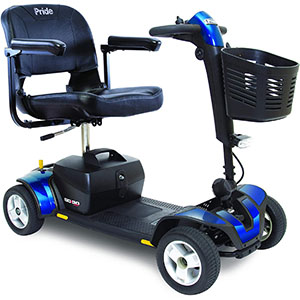
Click here for the lowest price on Amazon
The Pride Mobility S74 Go-Go is as handsome and comfortable as it is reliable and powerful. It has an outstanding weight capacity, it’s maximum range is one of the best, and is as stable as a mountain goat. If we had to pick just one mobility scooter, it would be the S74.
What we like: The S74 can accommodate up to 325 pounds, has a top speed just under 5 mph and features modular construction. It disassembles into 5 pieces for easy transport, has 3 inches of clearance, and handles minor hazards with aplomb.
Flaws: Taking it on a plane could be a bit of a chore.
2. Drive Medical SFScout4

Click here for the lowest price on Amazon
The SFScout4 from Drive Medical is comfortable, stable, and good-looking, with color-through panels that hides scuffs and scrapes. It will take you 15 miles on a full charge, makes short work of inclines and gives you a choice of 12AH or 20AH batteries.
What we like: The SFScout4 is designed with convenience in mind. It easily breaks down for transport, is nimble enough to navigate crowded sidewalks and malls, has flat-free tires, and the seat swivels to enable hassle-free mounting and dismounting.
Flaws: The ride can be a bit bumpy on uneven surfaces.
3. EV Rider MiniRider Travel Scooter

Click here for the lowest price on Amazon
The EV Rider MiniRider is stable, energetic, and has a clean modern profile. It doesn’t flinch when the surface changes from smooth to bumpy. And if you need to take it traveling, it comes apart and reassembles with ease.
What we like: The EV Rider MiniRider Travel Scooter is a pretty standard 4-wheel scooter design, but the steering column is a cut above. Ergonomically perhaps the best we tested. Really minimizes wear and tear on the arms and shoulders.
Flaws: Turning radius is wider than we’d like to see.
4. EWheels EW-46 Long Range Scooter
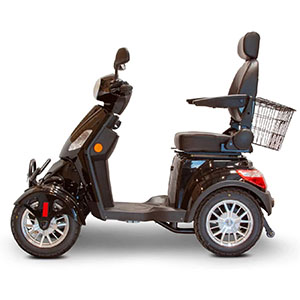
Click here for the lowest price on Amazon
If your tastes run more toward the luxurious, the EWheels EW-46 should be right up your alley. It seems a bit strange to use the words ‘mobility scooter’ and ‘luxury’ in the same sentence. But there is really no better way to describe the EW-46. It’s the Bentley of scooters.
What we like: The EW-46 features a best-in-class top speed of 13 mph and range of 35 miles. The maximum carrying capacity is an impressive 400 pounds and everything tilts, swivels or otherwise adjusts to make you more comfortable.
Flaws: Like a Bentley it’s going to put a dent in your retirement account.
5. EV Rider Transport Foldable Mobility Scooter
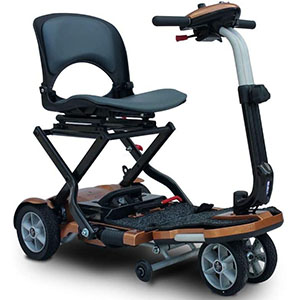
Click here for the lowest price on Amazon
EV Rider makes a second appearance on our list with their outstanding Transport Foldable Mobility Scooter. The TFMS embodies some of the best quality of more traditional foldups, while retaining the comfort and stability of fixed-frame scooters.
What we like: This scooter can be used as primary transportation or as a bring-along on road trips or overseas excursions. Total weight of only 46 pounds means most folks can handle it themselves, and the top speed of 4 mph is more than adequate.
Flaws: Like most fold up scooters the max weight is not terribly impressive.
6. BuzzAround EX Heavy Duty Long Range Scooter

Click here for the lowest price on Amazon
The BuzzAround EX generates a lot of positive buzz and most of it is well-deserved. The EX is light and tough, comfortable and handsome and features outstanding range and stability. It feels rock solid the minute you sit down.
What we like: The EX has one of the most comfortable rides you’ll find. We appreciate the bright LED head and tail lights, quick assembly, large tires and 330 pound weight limit. Charges in a hurry too.
Flaws: It’s going to cost more than most other mobility scooters.
7. Pride Jazzy ZT Zero Turn 8
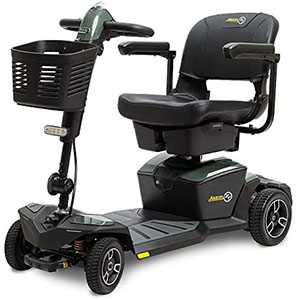
Click here for the lowest price on Amazon
Like most of the 4-wheel scooters we’ve looked at so far, the Pride Jazzy ZT Zero Turn 8 quickly disassembles for easy transport. But it’s more than a one-trick-pony. It’s also got a snazzy 21st century profile, turns on a dime and has plenty of lights for safety.
What we like: Suspension on the ZT is outstanding. Some of the best we encountered. Although modular, it feels rock-solid when assembled. And its 21st century cred includes a USB charging port for your smartphone.
Flaws: The 10 mile range is good, not great.
8. E-Wheels EW-72 Heavy Duty Scooter

Click here for the lowest price on Amazon
As we saw with their ‘luxurious’ EW-46 (see above) EWheels is not messing around when it comes to mobility scooter design. Their goal is to produce scooters that embody comfort and convenience while outperforming the competition.
What we like: With the EW-72 EWheels offers a top speed of 15 mph, a maximum range of 43 miles, outstanding stability, and an impressive weight limit of 500 pounds. And let’s not forget those nice big headlights for safety.
Flaws: Fast enough to get in trouble with. So ride with caution.
9. Pride Wrangler MV600 All Terrain Scooter

Click here for the lowest price on Amazon
If you live in an area where the terrain isn’t always silky smooth you’re going to like the Wrangler MV600. If you need to switch from asphalt to gravel to dirt to concrete it’s up to the task. It’s also very comfortable and stable.
What we like: Outstanding comfort and stability are two hallmarks of the MV600. Safety is another. It offers a top speed of 11.5 mph but gives you efficient hydraulic brakes that will bring you to a quick halt if need be.
Flaws: Forget about putting it in the trunk.
10. Metro Mobility Compact Travel Mobility Scooter
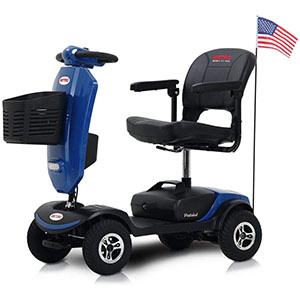
Click here for the lowest price on Amazon
The last of our best mobility scooters is from Metro Mobility. Their Compact Travel Mobility Scooter is an affordable, reliable alternative to other scooters costing two or three times as much.
What we like: This is a comfortable, dependable, stable scooter with a 5 mph top speed, a 16 mile maximum range (under ideal conditions), and a tough motor that handles inclines with ease.
Flaws: The 265 pound weight limit isn’t great.
Who Needs A Mobility Scooter?
Older individuals whose ability to get around under their own power is waning, or who suffer from debilitating conditions like rheumatoid arthritis (1) are obvious candidates for mobility scooters. But they’re not the only ones. Veterans scarred by war, people recovering from knee or hip surgery, those suffering from spinal stenosis or scoliosis, and skiers who’ve broken their legs are also likely to find mobility scooters make their life a lot easier.
How We Ranked
Mobility scooters are automobiles but there are still a lot of things to consider when trying to determine which merit inclusion on our ‘best of’ list.
The first thing we considered was how easy or difficult it is to operate a particular scooter. Some felt familiar the minute we sat down and featured intuitive operation. Others required some getting used to both physically and from an operational standpoint. And some felt like they were cobbled together from whatever was at hand.
Comfort was a big part of that intuitive feel. If the ergonomics were good, the seat comfortable and the ride smooth the scooter scored high. If we had to stretch to reach the steering, bottomed out on the seat or felt every pebble on the sidewalk we deducted points.
Stability was a major determining factor. The last thing you want is to tip over while riding your mobility scooter. So we put different people of different heights and weights on the scooters and had them execute an array of maneuvers. Those mobility scooters that stayed grounded made the cut. Those that flirted with tipping, or which actually tipped over, were removed from consideration.
Battery power was our next consideration. If a battery did not deliver at least 8 (and preferably 10) miles of operation it did not make our list. Ideally we wanted to see between 12 and 20 miles on a full charge. We also looked for a top speed between about 5 mph and 10 mph. Anything faster than that is flirting with danger.
The weight of the mobility scooter was also important. Especially so for fold up scooters. There is a bit of a balancing act with fold ups because you have to be able to lift them easily. But if they’re too light stability suffers. We looked for a range of between 50 and 150 pounds, depending on the style of the scooter.
Other factors that weighed on our choices included turning radius, carrying capacity, ground clearance, warranty and looks. Because, after all, who wants to ride an ugly mobility scooter?
FAQs
Q: What is a mobility scooter?
A: A mobility scooter is a battery-powered device that enables people with mobility issues to move about in public unaided. Mobility scooters have an electric motor, a padded seat, and a steering column. Which sets it aside from an electric wheelchair. Mobility scooters often resemble scaled down golf carts. Although, unlike golf carts, many mobility scooters are designed to fold up so they can be transported from place to place in a car or plane.
Q: Are mobility scooters safe?
A: Yes, mobility scooters are considered safe when used as intended. Because they move (relatively) slow and have a low center of gravity, instances of them tipping over are rare. Also, unlike bicycles, speed is almost never the cause of accidents. In fact, standard wheelchairs can attain much higher speeds than mobility scooters if the user has a strong upper body. Bicyclists, people on Segways, and skateboarders all have a higher rate of serious accidents than people on mobility scooters.
Q: Are mobility scooters and powered wheelchairs the same thing?
A: While both use battery power to transport the disabled person to and fro there are some major differences between a mobility scooter and an electric wheelchair. To start, the mobility scooter has a steering column, while the electric wheelchair uses a joystick. Electric wheelchairs are also shorter and have a higher center of gravity than mobility scooters. Scooters also have floorboards to rest your feet on, and they typically go further on a full battery.
Q: Can I take my mobility scooter on an airplane?
A: TSA allows people with a medical need for a mobility scooter to take the scooter on their flight with them. However, the scooter will typically be taken from you prior to boarding the plane and stowed with the checked baggage and you will be taken on and off the plane in a manual wheelchair. You will need to tell the airline when you make the reservation that you are bringing a mobility scooter. If you don’t there could be significant delays when you get to the airport.
Q: Which is better, a 3 or 4-wheel mobility scooter?
A: Each have their pros and cons. The big advantage of 3-wheel mobility scooters is that they can turn on a dime. Many people find this ability to zig and zag especially useful for navigating crowded malls and city sidewalks. However, you lose a bit of stability with the 3-wheel design. 4-wheel scooters offer greater stability, often have higher ground clearance, and are better at handling uneven surfaces. They usually have a higher weight limit as well.
Q: Are all mobility scooters foldable?
A: Not all mobility scooters can be folded up and stored away. But there are dozens of models that can. Before you decide to purchase a mobility scooter you should first decide how you’re going to use it. If it will be your primary transport, you may want a non-folding model as they are usually larger and sturdier. If, however, you will mostly be taking the scooter with you when you drive places in your car then a fold up scooter is a better choice.
Q: Are mobility scooters expensive?
A: As is the case with cars and bicycles the cost of mobility scooters varies significantly depending on the make and model. Some can be had for a few hundred dollars. Others will cost 10 times that much. What you will typically get for the much higher price is a more powerful, longer-lasting battery, high quality materials, dependability and a longer, more comprehensive warranty.
Q: Will Medicare pay for a mobility scooter?
A: Medicare will cover most of the cost of a mobility scooter. As long as it has been deemed necessary by your physician and you pay 20% of the Medicare approved cost (2). That last bit about the ‘Medicare approved cost’ is important, and here’s why. Let’s say your scooter is $1,500. The Medicare approved price may be only $900. Which means you will need to cover 20% of $900, plus everything over $900. So your end would be $180 + $600, or $780.
Q: Do I have to wear a helmet when driving a mobility scooter?
A: There are currently no laws that require helmets when riding mobility scooters. This is likely because mobility scooters move much slower than bicycles. Alarmists will often overstate the threat posed by riding a mobility scooter. But the fact is serious injuries related to mobility scooters are extremely rare. By contrast, more than 6,000 pedestrians are killed walking down the street each year in the US (3). So unless helmets are going to be required when walking, then there is little reason to make them mandatory for mobility scooters.
Q: What it the top speed of a mobility scooter?
A: In the case of mobility scooters faster is not necessarily better. The faster you go the greater the risk of tipping over, and the greater the risk of hitting a pedestrian, tree or other obstacle. There are a small number of mobility scooters on the market that are capable of hitting 10+ miles per hour. But the vast majority come in at around 4 or 5 mph. This is still faster than the average healthy adult walks (4) and should be more than adequate for most people.
Q: Can mobility scooters go uphill?
A: Of course. But just as with cars, trucks and every other type of vehicle there are a few things you will need to consider. If the grade is more than 18% your scooter may have a hard time handling it. But don’t worry, few sidewalks have more than a 5% grade. Weight is another consideration since the greater the weight the greater the strain on the electric motor. Especially when climbing any type of gradient.
Q: Do I need collision insurance to drive a mobility scooter?
A: As of this writing you are not required to carry liability insurance in order to operate a mobility scooter. However, we live in a litigious society where people have their lawyer on speed dial, so it’s often a good idea to carry some amount of liability insurance if you can afford to do so. Because some of these mobility scooters are not cheap, you might also want to insure the scooter itself against theft or damage.
Q: How far will a mobility scooter go before the battery dies?
A: Most scooters will have a maximum range of between 12 and 20 miles. In the overwhelming majority of cases this is more than sufficient range for people to run errands, visit friends, and take a ride through the park etc. Each scooter will be different, however, so make sure you confirm the maximum range before you purchase the scooter.
Q: Do I have to wait until the battery is empty to recharge it?
A: As a general rule you should recharge your mobility scooter at the end of every day. Unless, of course, you did not use it that day. That said, battery makers often provide their own guidance on when you should or should not charge the mobility scooter battery. Some will state that you shouldn’t charge it if it is more than 80% full. While others say not to keep the battery plugged in once it’s charged. Be sure to check the instructions that come with the scooter.
Q: How long does a battery last on a mobility scooter?
A: Like every other product the quality of mobility scooter batteries will vary. Some will provide a couple of years of dependable, everyday use before they need to be replaced. Others might start to fade after a year or less of intermittent use. Signs that the battery is fading include decreased range, trouble climbing gradients it used to handle easily, and decreased overall capacity. If you notice these signs don’t wait to get stranded to replace the battery.
Q: Can I use a mobility scooter in the winter?
A: Mobility scooters are not season-specific. They’re designed for outdoor use with the understanding that the weather isn’t always sunny and mid 70s. Most can handle a lot, including light rain and snow, hot temps and cold. Heavy rain and more than a light coating of snow are another story. Heavy rain will present a danger to the scooter’s electrical circuitry. And any snow deep enough to prevent the wheels from contacting the pavement is too deep.
Q: Can I take a mobility scooter anywhere?
A: Places that are publicly accessible are supposed to be accessible to handicapped individuals. Indeed, the Americans with Disabilities Act, or ADA (5), states clearly that publicly accessible spaces like shopping malls and amusement parks must accommodate mobility devices in all areas where the general public is allowed, unless there are “legitimate safety requirements” that make such an accommodation impossible (6).
Q: Do mobility scooters require maintenance?
A: They do. But typically the amount of maintenance they require is fairly modest. In some cases it’s just a matter of cleaning grime off the wheels and axles, cleaning the seat and checking that there are no loose parts flopping around that could present a hazard. Most mobility scooters, however, will also require that you have the device checked out by a professional once a year. If you don’t, it will likely void the warranty.
Related Articles
Recap
Mobility scooters enable the elderly, sick, and injured to stay engaged with life. They’re safe, reliable and – because Medicare will often cover a large portion of the cost – affordable as well.
Mobility scooters are designed to operate in all kinds of conditions except heavy rain and snow, and don’t require any special training or license.
The mobility scooters profiled above run the gamut from simple and inexpensive to feature-rich and not so inexpensive. All were extensively tested by our product review experts and earned their place in our rankings.
For cpoe.org’s #1 recommended mobility scooter, click here.

